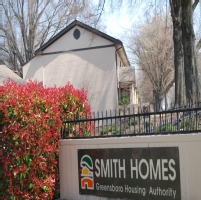Expansion of Low-Income Family Housing
The first two public housing developments were built in 1951 as segregated communities. Smith Homes served the Caucasian community, while Morningside Homes served the African American community.
The Henry Louis Smith Homes (Smith Homes), Greensboro’s first public housing community, was constructed in the southwest section of the City and still operates at its location of Florida Street and Freeman Mill Road. The development, named for Commissioner Dr. Henry L. Smith (1941-1947), currently has 430 units and houses over 1,000 residents.
Morningside Homes, built in the eastern section of Greensboro, included 400 units. This community was demolished in 2002 to make way for Willow Oaks, a mixed-income community.
In 1959, GHA expanded its vision and added an additional community, Ray Warren Homes. The development, which contained 236 housing units for Greensboro’s low-income families, was named for GHA’s first Executive Director, Ray Warren (1941-1956). Located off Lee Street in Greensboro, the site currently houses 545 individuals.
On January 27, 1964, Hampton Homes was established. It would take from 1962, when GHA was notified of financial assistance, to 1968 for the completion of the community. Hampton Homes, which is located off S. Eugene Street in Greensboro, received a complete modernization beginning in December 2002. The project included the complete redesign of the community’s 275 units’ exterior and reconfiguration of the interiors, and the addition of a large resource center that houses GHA’s Assisted Housing staff, a Police Neighborhood Resource Center, computer lab, wellness center and meeting rooms. The modernization of Hampton Homes was completed in May 2010.
Claremont Courts would become GHA’s last large public housing community. Completed in 1969, the community includes 250 units and is located in the northeast section of Greensboro.
In addition to the changes in Public Housing, the Leased Housing Section 23 program was introduced in 1967. Under the new program, the Housing Authority was authorized to lease privately-owned dwellings and sublease them to low-income citizens at reduced rents. The Section 23 program was the forerunner of the current Housing Choice Voucher Program that provides rent subsidies to eligible families.
Separate communities for Greensboro’s elderly became a reality with the addition of Hall Towers, Gateway Plaza and Stoneridge. While there were existing units for elderly and disabled residents in some of GHA’s larger communities, they were not designed specifically to meet the needs of this special population. Once again, GHA began a search to acquire land and begin construction.
Alonzo C. Hall Towers, named in honor of GHA’s first chairman of the Board of Commissioners, was built on its current site on N. Church Street in 1970 and became the first of two high-rise communities for the elderly. Gateway Plaza, the second high-rise elderly community, was built in 1975 and is located on Spring Garden Street in downtown Greensboro.
Stoneridge, an existing community that was acquired by GHA in 1978, gave the Greensboro elderly another choice in housing. Located in a secluded area close to the intersection of Holden and High Point Road, this small 50-unit community is a quiet, more rural neighborhood.
The 1980’s brought public housing away from the large communities of the past as GHA began to build smaller scattered-site housing throughout Greensboro. This move did not come without controversy as many Greensboro residents were opposed to public housing being constructed in their neighborhoods.
Hickory Trails, the largest of the scattered sites, was built in 1980 with 107 units and an annex was added two years later with 20 additional units. The site on which the community was built was one of the most contested locations for public housing in the City.
Baylor Court, with 11 single-family units, and Woodberry Run, with 39 units, were also built in 1980. Other small communities were constructed in the 1980’s including Applewood, Pear Leaf and Silverbriar, all containing 50 units, and Lakespring, a slightly larger community with 60 units.
Two additional public housing communities were built during the 1990’s. Laurel Oaks and Riverbirch, both with 50 units, were added to GHA’s scattered-site program.
Crime in GHA’s largest public housing communities became an increasing problem for residents and the City. In 1990, in an effort to decrease the crime rate, GHA, its residents and the Greensboro Police Department began a joint effort to establish Police Neighborhood Resource Centers (PNRCs) in the larger public housing communities. PNRCs now exist in five GHA communities and include a task force of officers assigned to specific neighborhoods and PNRC managers who provide information to residents about services available to them. This successful program has been given national attention and has decreased crime in the participating communities.
With an objective to revitalize and return the Morningside Homes community to its original position as a quality “work-force” neighborhood, GHA began the transformation of Morningside Homes. The new Willow Oaks community is now a reality through the use of HOPE VI, City of Greensboro and NC Housing Finance Agency funding. The development features a large community center with meeting rooms, a childcare center and exercise room; a senior village with 40 bungalow-style units; 170 town homes; and single-family homes for sale for low to moderate-income families. Senator Elizabeth Dole addressed those attending the grand opening in August 2006. “It’s a remarkable achievement,” the Senator said, “What a remarkable turn-around! Not only do residents have the keys to a new home, they have the keys to a better way of life.”




